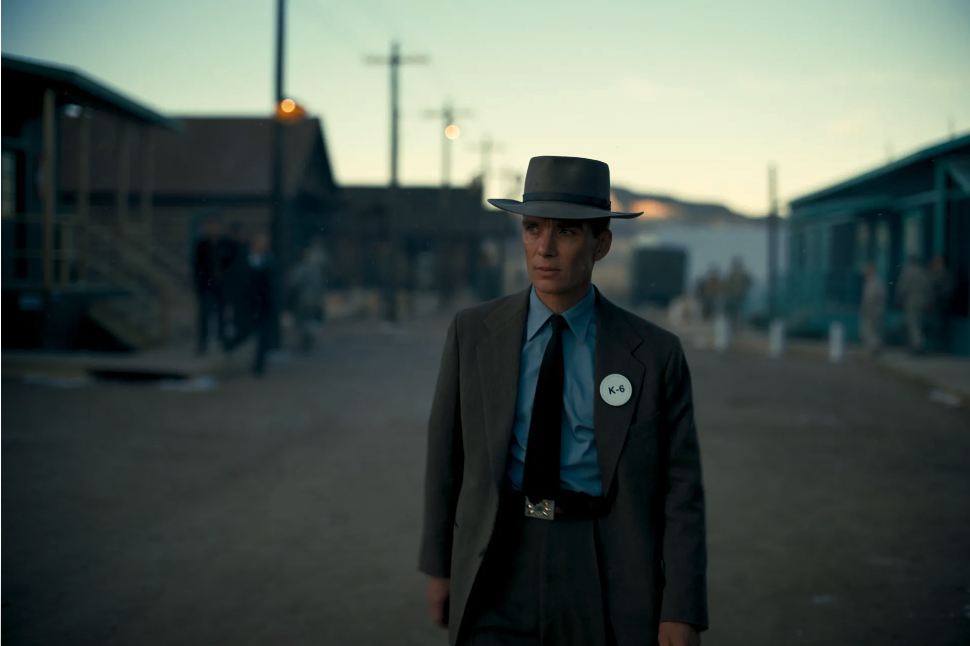Oppenheimer Movie Review | The Mystery of Its Success
by Garry Murdock

IMAX
The film Oppenheimer is a mystery to me; here is a movie just over three hours in length, yet there are no gunshots, no car chases, no fist fights, rarely does anyone swear, and we don’t actually see atomic bombs being dropped on Hiroshima and Nagasaki. There is some brief sex in it, but the two people involved don’t seem to be enjoying themselves. We’re left with a tremendous amount of dialogue and very little action. Yet the movie has grossed $950 million worldwide and is now the highest-grossing biographical film of all time. It’s also closing in on the highest-grossing ‘R’ rated film of all time (although here in Canada the film is rated PG14). I have to ask: How is $950 million in box office even remotely possible, in a world of shortened attention spans and superhero films?
Don’t get me wrong, I’ve been guilty of a shortened attention span too from time to time but The Journal recently polled 8,000 moviegoers to discover that two hours is the limit for a film’s length for most cinema enthusiasts. Only 12% were interested in three-hour movies. I believe superhero films definitely have their place too, as I loved Avengers: Endgame, Doctor Strange and Spider-Man: No Way Home (among many others). But I digress.
Robert Oppenheimer is the hero of this story, and he has been tasked with overseeing the infamous Manhattan Project’s Los Alamos lab in New Mexico during World War II. His team’s mission is to build the world’s first atomic bomb before the Germans do. But make no mistake—this is Oppenheimer’s story: every scene is about Oppenheimer, his decisions, and the repercussions of those decisions that will haunt him for the rest of his life. Viewers who are expecting a drama about American B29s dropping bombs on two of Japan’s cities need to look for another film.
Oppenheimer’s life is messy; he has a mistress, and a supporting but sometimes unforgiving wife. He is living in a time where if your politics skew even a little left-wing, well then you are automatically labelled a communist. The fear of spies is a very real one. Oppenheimer has decided that the best way to proceed with the project is to have the military build a fully functioning town (that means in addition to labs there are homes, schools, a post office, a barbershop, bars and more) in the middle of the desert at Los Alamos. This is not only to hide their work from prying eyes but so that scientists can bring their families along with them as the project is expected to take anywhere from one to three years. In fact, it will take the full three years, employ four thousand people, and cost 2 billion dollars (that’s over $35 billion today).
As the film progresses, we come to realize that Oppenheimer is conflicted about his work: “I don’t know if we can be trusted with such a weapon, but I know the Nazis cannot. We have no choice.” You see, the bomb was originally meant for Germany, not Japan. Complicating Oppenheimer’s job is that the scientists do not always agree, as there is an ongoing argument about whether the bomb should be hydrogen or atomic. Oppenheimer, besides spearheading the project, also has all the duties that come with running a town, along with the lies, petty jealousies and backstabbing such responsibility and power seem to invite.
Intrigued yet?

It is a remarkable story. Maybe all the more so because it’s true. Director Christopher Nolan wrote the script based on Kai Bird and Martin J. Sherwin’s book—which took years to write. In the hands of a lesser director some of the scenes may have felt too long, too dialogue-heavy. But not here. Maybe that’s because the story has taken us to a point in history where almost every decision is critical, where a mistake could end America’s hopes of winning the war. In just one of the many tense moments in the film, we learn alongside Oppenheimer that the test bomb they’re building in the desert (code name: Trinity) could set fire to the Earth’s atmosphere and end the planet.
The editing is a marvel; it keeps the movie moving right along even though we are jumping continuously back and forth through time. This is accomplished by switching from colour to black and white scenes, and then back again. Of course, black and white 65mm IMAX film didn’t exist until Nolan requested it, but it certainly makes a difference; the detail is startling in its clarity even when not watching the film in an IMAX theatre. Usually, IMAX is reserved for those big action shots or vistas, here they are used intimately for close-ups of the talent too. What action there is in the film is done through practical effects, you will find no CGI here. This means the spinning atoms, the explosions and shock waves we see were all created by an effects team in real-time. Wow.
Cillian Murphy leads the cast as Oppenheimer in a stellar performance. Murphy doesn’t get to express the range of emotions that he mastered so well in the award-winning TV series Peaky Blinders, but he does play the man with an understated charisma that fuels his leadership. When Hitler commits suicide and Germany is on the verge of defeat, he calmly rallies the troops when his scientists start getting vocal about ending the project. In a calm and measured voice he tells them that the war is not over, that there’s still Japan to consider: “When the world learns the terrible secret of Los Alamos, our work here will ensure a peace mankind has never seen.”
Emily Blunt plays Kitty, Oppenheimer’s wife, and she is not playing the stereotypical housewife of the 40s (or any decade). She doesn’t look glamorous, she looks tough. In fact, she is a force to be reckoned with in almost every scene she’s in. It is Kitty, who, maybe because she is a step back, can put things into context and see who the real enemies are.
The real surprise here is Robert Downey Jr, in what may be his best performance since his Oscar-nominated work in Chaplin thirty years ago. He plays the conniving Lewis Strauss, one of the original members of the Atomic Energy Commission who, for slights (some real, some imagined) pretends to support Oppenheimer while at the same time seeking revenge by attempting to have his security clearance revoked. Such a move, if successful, would end Oppenheimer’s career.

There are a lot of other familiar faces in this movie: Kenneth Branagh plays Niels Bohr, a Danish physicist and friend. Gary Oldman is President Harry S Truman in one (very powerful) scene and Matt Damon is General Groves, the man who recruits Oppenheimer. Florence Pugh plays Jean, an old girlfriend who won’t go away, even after Oppenheimer marries. I would best describe Pugh’s performance here as “intense” as their relationship will have a profound effect on the man in the years to come. I wish we could have seen more of her.
You’ll also see a lot of other faces you can’t quite place, these are the actors you’ve seen in countless other movies and TV shows but can never remember their names, such as the always reliable James Remar—who plays Secretary of State Henry Stimson. In an astonishing scene—one that makes you scratch your head and wonder “Did that really happen?!”—Stimson announces at a closed-door Japan strategy meeting: “We have a list of twelve cities to choose from (to bomb). Sorry, eleven. I’ve taken Kyoto off the list due to its cultural significance to the Japanese people…also, my wife and I honeymooned there. It’s a magnificent city.” The reaction among his colleagues is blank stares.
I’ve come to conclude that Oppenheimer succeeds and succeeds so spectacularly, even with the lengthy run-time, is because all of the film’s elements were so well thought out and executed. What we have here is a well-researched and detailed screenplay, masterful directing, awe-inspiring special effects and editing, and an A-list cast. Special mention should also be made of the set work (they did create a 1940s town after all), period costumes and props, and musical score. No doubt this movie will be up for a great deal of Oscar nominations (I would hope it at least wins for Best Picture, Best Director, and for Downey Jr). It’s already been announced that the film is not on the shortlist for best visual effects, which is a real shame when you consider Barbie is on that list.
The man Oppenheimer may have been ahead of his time. Once the bomb was built, nobody wanted to hear from arguably the greatest scientist in the world anymore. After all, his job was done and he has readied two working atomic bombs. However, Oppenheimer wanted the government to at least consider using the bombs only as a deterrent or perhaps as a last resort. Sadly though, you can see his power diminishing rapidly after the Trinity test explosion in the desert works perfectly. When the finished weapons are being loaded onto trucks to destinations unknown, he attempts to suggest their use only to be shut down by one impatient soldier: “With respect, Doctor Oppenheimer, we’ll take it from here.”
Oppenheimer was no doubt chilled at this response, as was I.
About the Writer



